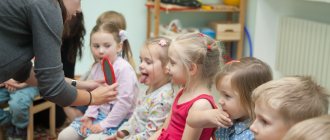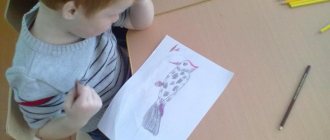Summary of GCD in the middle group of kindergarten on the topic “Vegetables”
Direct educational activities for children 4-5 years old on the topic “Vegetables”
Program objectives: 1. Consolidate and clarify children’s knowledge about vegetables; 2. Continue to develop the ability to solve riddles; 3. Develop speech activity and attention; 4. Develop the ability to distinguish vegetables by touch and taste; 5. Practice selecting adjectives; 6. Cultivate diligence when completing tasks. Material: • Vegetables;
• Dummy vegetables; • Opaque pouch; • Pictures for coloring “vegetables”; • Pencils, felt-tip pens. Progress of the lesson:
Educator: I will start our lesson today with riddles. In order to guess them, you need to listen to them carefully. You are ready? Children: Yes Riddles
I tried all summer - Dressed, dressed... And when autumn approached, She gave us our clothes.
We put a hundred clothes in a barrel. - cabbage - I dragged the fox out of his mink by his curly tuft. It feels very smooth to the touch, it tastes like sweet sugar. - carrots - Doesn't upset anyone, but makes everyone cry. - onion - There is a yellow ball in the garden, But it doesn’t run at a gallop, It’s like the full moon, The seeds in it are delicious. - pumpkin - How riddles grew in our garden bed, Juicy and large, So round. They turn green in summer, and turn red in autumn. tomatoes Our piglets grew up in the garden, sideways towards the sun, crocheted tails. These piglets play hide and seek with us... Cucumbers If you want a vinaigrette, go to the garden for it, It has a beautiful color Both outside and inside! Beetroot It can be very different - Green, yellow, red, It’s both hot and sweet. It’s worth knowing its habits. Pepper Teacher : Well done! You are all very attentive and smart. They guessed carrots, cabbage, onions, and peppers. How can all this be called in one word? Children: Vegetables. Educator: Correct. That's what we'll talk about today. “Vegetables” is the topic of our lesson today. Conversation Teacher: How many of you know the difference between vegetables and fruits? Children's answers Educator: Where do vegetables grow? Children: Vegetables grow in the garden, in the garden Educator : What is the name of the profession of a person who grows vegetables? Children: Vegetable grower Educator : What are vegetables for? Children: Vegetables are needed to be eaten. Educator : What can be prepared from vegetables? Children : Salad, borscht, cabbage soup, fry, eat raw, etc. There are vegetables (or dummies) on the table. The game “What’s missing?” Children close their eyes. The teacher removes one of the vegetables, the children open their eyes and answer what is missing. Game “Wonderful Bag” The teacher puts dummies of vegetables into an opaque bag. Children take turns recognizing vegetables by touch. Educator : Well done! How many of you like to eat vegetables? Children's answers Raised spruce: Guys, vegetables are very healthy, they contain a lot of vitamins. You definitely need to eat them. But before you eat them, you need to do a very important thing. Which? Children : Wash them Teacher : Correct. Game “Guess the Taste” Raised spruce: I washed all the vegetables and want to treat you to them. But not just to treat, but so that you can guess the taste of the vegetable. To do this you need to close your eyes. The teacher gives the children a small piece of vegetable, the children guess.
!!!
Note: The teacher must know for sure whether children are allergic to certain vegetables. Educator : Okay, you completed the task. As you have already noticed, vegetables have different tastes, colors, and touches. Choose a suitable description for each vegetable. Game "Which vegetable?" Children are shown pictures of vegetables and asked to characterize them:
Onions - bitter, white, aromatic, round;
Carrots are orange, long, sweet, tasty, healthy, etc. Educator : Now you know everything about vegetables, their taste, color and shape. I suggest sitting down at the tables and coloring the pictures.
We recommend watching:
Abstract of direct educational activities for children of the middle group. Abstract of educational activities for mathematical development in the middle group. Crossword puzzle with answers for children 6-7 years old. Vegetables Synopsis of a cognitive lesson on the topic “Vegetables”. Second junior group
Similar articles:
Riddles about vegetables for children 6-7 years old with answers
Poems about vegetables and fruits for children 5-7 years old
Summary of GCD in the middle group. Vegetables
GCD summary.
Middle group on the topic: “Vegetables” Goal: To develop children’s interest in knowledge about vegetables through the integration of educational areas: cognition, communication, artistic creativity. Objectives: To form children’s ideas about vegetables, the place of germination and their preparation for the winter;
Strengthen children’s ability to describe vegetables according to their characteristic features, according to the diagram; Improve the ability to write grammatically correctly and consistently construct your statements; Expand the active vocabulary, activate the names of vegetables in children’s speech. Continue to develop in children the ability to distinguish and name colors, practice comparing objects by color; Encourage children to answer questions by pronouncing words clearly. To develop children’s ability to coordinate movements with text, understand and follow verbal instructions; Develop visual perception and memory, motor imagination and coordination of movements; Develop fine general and fine motor skills of the hands; Cultivate a friendly attitude towards peers; Create a favorable emotional atmosphere and conditions for active play activities of children. PROGRESS OF THE CLASS:
Vos: Guys, guests came to us today, let’s greet them. The group suddenly became lighter, and the guys had more fun. Because at that hour the guests visited us. We welcome you with joy and wish you good health. Feel at home, the place is ready for you, We invite you, sit down and rest from the road. And now let’s tell our guests in verse what we will do now: Our smart heads will think a lot cleverly, Our ears will listen, our mouths will speak clearly, Our hands will clap, our legs will stomp, Our backs will straighten, we all smile. Voss: Look guys, I have multi-colored balloons, I’ll give them to you now. Question: What color is your ball? (Children's answers) Voss: On your chairs there are mugs of the same color as the balls, let's play the game “Find your house.” On my command 1, 2, 3, run to your house. Questions: Why did you choose this house? (Because the ball is red and the circle is red, etc.) Voss: Well done guys, they all found their houses correctly, Tell me, what time of year is it now? (Autumn) Why do you think so? (Children's answers) Voss: Guys, autumn gives people many gifts, remember what she recently gave us? Children: A basket of autumn leaves. Vos: That's right, but we can admire the leaves, and autumn has gifts that we can enjoy. These are vegetables and fruits. They contain many vitamins that are necessary for us to grow healthy. Surprise moment: (Crying is heard) Voss-l: Children, hear, someone is crying, let's go and have a look. (A hare appears from behind the screen) Voss: Who are these guys? (Bunny) Voss: Ask why the bunny is crying? Bunny: How can I not cry? My mother sent me to buy vegetables, but I don’t know what vegetables are and where they grow. Voss: Don't cry, bunny, we will help you. Children, tell me where vegetables grow? (In the garden in the garden bed) Let's go to the garden with you: Our legs are walking along a level path. We jump through a puddle, jump through a hole, oh, tired, where have we ended up? Voss: Where have we come? (To the garden) How can you say in one word what grows in the garden? (Vegetables) What vegetables do you see here? (Children's answers) What do people do in the garden in the fall? (They are harvesting) Voss: That's right, but not all vegetables are harvested the same way; vegetables are dug up, cut down, pulled out and picked. Do you know what vegetables are collected and how? How will we collect potatoes? (Children's answers) Voss: Children, collect the harvest of vegetables in a basket. How many vegetables are there? (A lot) Voss: Let's talk about vegetables. And to make it easier for you, I have prepared this diagram (name, shape, color, how to assemble it). Voss: Well done, guys, now treat the bunny with vegetables. Vos: I suggest you rest a little: (finger gymnastics) There are a lot of beds in the garden, there are carrots and lettuce, there are cucumbers and peas, but aren’t potatoes bad? Our green garden will feed us for a whole year. Bunny: Guys, do you know how to plant vegetables? Teach me? Voss: I have prepared dough for you, from which we will make a bed. And then we plant what? (Carrots and potatoes) Voss: That's right, we will plant carrots, and we will bury potatoes. Roll the dough into a sausage - this will be the garden bed. Questions: What are you doing? (Bed) What will you plant? (Children's answers) What is your garden bed with? (With potatoes, with carrots) Recreational: After work, it’s time to relax: Logorhythmic exercise: We’ll go to our garden and pick vegetables there (they walk) There’s cabbage and onions (putting hands forward in turn) There’s beets and garlic We’ll take baskets ( Tilts) We will collect our harvest. Bunny: Oh, while you were doing a round dance, my brothers hid all the vegetables, help me find them. Voss: Guys, go to these plates and find all the vegetables. Questions: What vegetables are hidden in your plate? Voss: Let's return the vegetables to the bunny. Bunny: Thank you children, but tell me what needs to be done to have vegetables on the table all year round? Children: They must be stored. Voss: Let's pickle the vegetables. Look, I have two jars? What's different about the cans? (Lids) That's right, lids. What color are they? (Red and green) What vegetables will we salt in jars? (Tomatoes and cucumbers) Pickle tomatoes in a jar with a red lid, and pickle cucumbers in a jar with a green lid. Questions: In a jar, with what lid did we pickle the cucumbers? In the jar, with what lid did we pickle the tomatoes? Voss: Now let’s salt the cabbage. Finger gymnastics “Cabbage”. Voss: Look how much children know about vegetables and how to prepare them for the winter. Bunny: Thank you guys, you helped me a lot, I really liked your place, but it’s time for me to go home to my mother, goodbye. Voss: Guys, the bunny was in such a hurry that he forgot to say that he left some treats for you, help yourself to your health. Questions: What do you treat yourself to? (Children's answers) How to call treats in one word? (Vegetables) What is in vegetables? What are vitamins for? Voss: Guys, the bunny also gave you “Vegetables” coloring books. You can color them in a group, and in the evening show them to your parents and tell them what vegetables are and where they grow. If you want to color them, then let’s say goodbye to our guests and start drawing.
We recommend watching:
Summary of GCD in the middle group “Mushroom Glade” Summary of GCD. My city Zheleznogorsk Summary of GCD in the middle group with elements of experimentation Integrated GCD for speech development and artistic creativity in the middle group
Similar articles:
Lesson summary for the middle group: Safety at home
Summary of a lesson in kindergarten “Receiving guests.” Middle group
Lesson summary for the middle group on the topic: Properties of glass
Lesson in the middle group of kindergarten. Village courtyard
Summary of a lesson on cognitive development in the senior group. Rules of conduct in the circus




